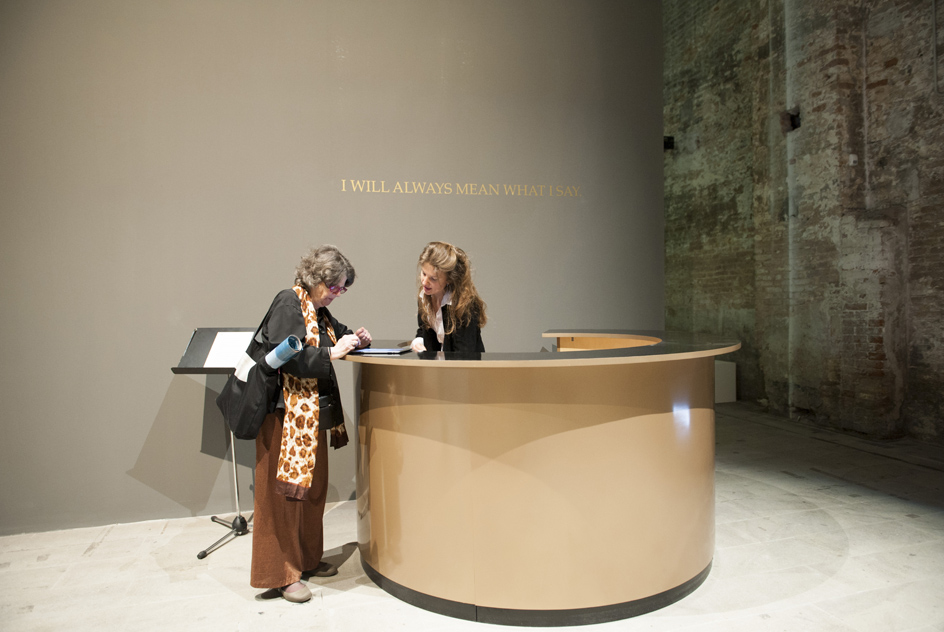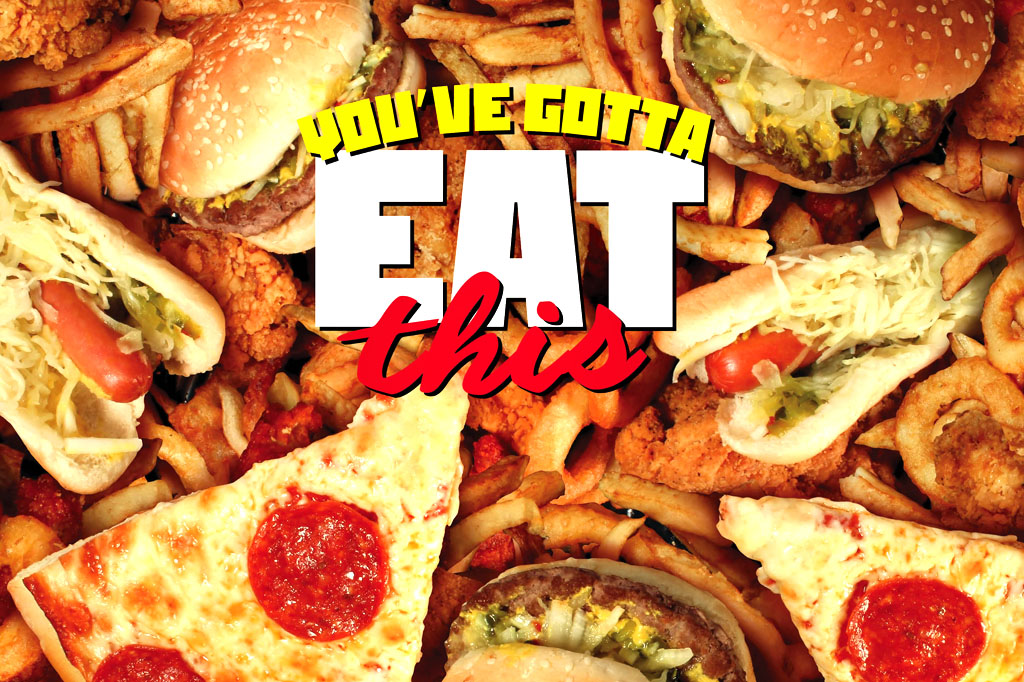The Coolest Art At The 56th Venice Biennale

Simone Ubaldi is a ghostwriter, music journalist, film critic and…
The Venice Biennale is a citywide takeover of contemporary art. After a failed bid to have Kanye West installed as curator, the 2015 edition rolled out as planned – a massive showcase of creative voices from around the globe, from Albania to America to Azerbaijan; Iceland to Indonesia; Turkey to Tuvalu.
With a themed, curated show at the Arsenale, national pavilions lining the Giardini and dozens of collateral events in palazzos and galleries across the sinking city, you could spend weeks navigating the world’s most prestigious art event. Alternatively, you can sample the best with the help of this handy list.
Carsten Höller, ‘Fara Fara’ (Belgium)

Carsten Höller, the artist best known for attaching multi-story slides to the facades of contemporary art galleries, has a killer two-channel video work at the Biennale. ‘Fara Fara’ documents a showdown between to Congolese hip hop artists, which takes place over one long night in a rammed sports stadium in Kinshasa. The film drops you into another world, eminently cool but also alien, full of ecstatic life. It’s a startling reminder that mass culture can exist off the grid, un-excavated by Buzzfeed (at least for now).
Sonia Boyce, ‘Exquisite Cacophony’ (UK)
Video artist Sonia Boyce set up and documented an unusual happening at the Victoria & Albert Museum in London – a completely improvised spoken word sound-off between dapper rapper Astronautalis and sound artist Elaine Mitchener. Screened as a video work at the Venice Biennale, their rambling conversation is sexy, funny, anarchic and clever, bouncing joyfully off the walls of that hallowed institution.
Mika Rottenberg, ‘NoNoseKnows’ (Argentina/New York)
In Mika Rottenberg’s trippy video installation, giant balloons float and pop in pastel-shaded corridors, a ruddy office worker sniffs floral bouquets while her nose grows Pinnochio-style, factory workers sort mounds of luminescent pearls and plates of ramen noodles grow in stinking piles. An oblique comment on the subject of human capital, Rottenberg’s film feels like Buñuel and Dali directing Willy Wonka and the Chocolate Factory.
Ibrahim Mahama, ‘Out of Bounds’ (Ghana)

A long passage behind the Arsenale building is festooned on either towering side with the kind of ropes and rigging used in industrial shipping. You could easily miss the installation, called Out of Bounds, which is why it’s so effective. This hulking, dark and unsettling space is hidden out of sight, echoing the unseen global trade of drugs, guns and human traffic.
Lu Yang, ‘Other Future’ (China)
The Biennale is heavy with video art and a lot of it seems to be “meditative” footage of empty public squares in the Ukraine or people catching trains in Siberia. Over in the Chinese Pavilion, however, the video art goes maximum Street Fighter/Raging Buddhist. In the centrepiece film of his ‘Other Future’ installation, Shanghai animator Lu Yang has cast a bunch of men as Tibetan deities and has them posing aggressively against backdrops that resemble magic eye puzzles, while epic tunes signal some forthcoming end-of-civilisation battle. This hypnotic, brain-melting stuff comes from an artist whose previous works include drum-n-bass fuelled anime film ‘Uterus Man’ and a day-glo Pikachu-flavoured animation called ‘Cancer Baby’.
Fiona Hall, ‘Wrong Way Time’ (Australia)

Fiona Hall has knocked it out of the park with her richly textured takeover of the Australia Pavilion. Featuring embroidery, cabinetry, masks, wall-clocks, sculpted sardine cans, puppets and an assembly of histrionic front pages from Murdoch newspapers, her dark, dense vision of Australia reflects a dark, difficult moment in our cultural history. For those less politically inclined, the minutia of Hall’s craft is pretty intoxicating.
Willem Bosheff, ‘Racist in South Africa’ & Gerald Machona ‘Ndiri Afronaut’ (South Africa)
The South Africa Pavilion is full of provocative work, including a silver wall plate by Willem Bosheff, inscribed with a creed that begins, “I am proud to be labelled a racist in South Africa if…” and goes on to highlight some of the complex issues around poverty, crime and race in that part of the world. On the less controversial side of things, there is a balletic black and white video piece by Mohau Modisakeng and another video work by Zimbabwean-born Gerald Machona, which features a displaced astronaut dancing through the streets of Soweto. The astronaut’s suit – made from decommissioned Zimbabwean dollars – sits in the pavilion beside the video screen.
BGL, ‘Canadissimo’

Artists Jasmin Bilodeau, Sébastien Giguère and Nicolas Laverdière have transformed the Canadian Pavilion into a dusty corner store, complete with strip lighting, working fridges and shelves full of legitimate goods, and a back room piled high with used paint cans. It’s weird stepping into an installation piece that looks, down to its dust motes, like a forgotten corner of the actual world. It’s stranger yet when you focus on the packaging in the store and realise that some of the words are slightly out of focus, messing with your eyes. It makes the ersatz reality twitch like a glitch in the matrix.
Sarah Lucas, ‘I Scream Daddio’ (UK)
Sarah Lucas is doing her part for the shock-and-awe value of contemporary art. The survey of her work at the British Pavilion includes epic sculptures of balloon animals that resemble sagging male genitalia and plaster casts of women who have cigarettes protruding from various vulgar places. It’s pretty funny.
Palazzo Fortuny, ‘Proportio’

As mentioned, the Biennale extends to dozens of collateral exhibition in private houses and palazzos around Venice. Of these off-piste shows, the most dazzling and beautiful is Proportio at the Palazzo Fortuny, which examines the “sacred logic” of proportion through a juxtaposition of antique objects and 20th century art. Architectural models of 18th century Venice sit beside sound art by Marina Abramovic, sculptures by Anish Kapoor and video work by Bill Viola, all housed in the stunning gothic art museum that was one of the inspirations for MONA.
Hito Steyerl, ‘Factory of the Sun’ (Germany)
Deep in the bowels of the German Pavilion, artist Hito Steyerl has built a 3D Tron experience – a huge black box cinema lined with a glowing blue grid lines. Looming in one corner is a cinema screen, showing Steyerl’s chaotic film ‘Factory of the Sun’. In the film’s techno dystopian narrative, ravers are slave labourers in a motion capture studio, which from the outside looks like an abandoned nuclear plant in Soviet Russia. Part Fifth Element, part Dance Dance Revolution, the incoherent, exploding narrative of ‘Factory of the Sun’ ensures the Tron cinema lives up to its surreal, retro-futuristic promise.
Adrian Piper, ‘All the World’s Futures’ (USA/Germany)

Adrian Piper’s Golden Lion-winning work at the Arsenale isn’t much to look at, just a few grey service desks, a few tablets and a few hulking printers. Above each desk is a declaration, eg ‘I will always do what I say I am going to do.’ You walk up to a desk and give your details to the attendant, who then prints out a contract based on the declaration. You sign the contract and walk away – no one need ever know. But a copy of your contract is sent back to Berlin and it will sit in the Piper Archive forever. You might forget your promise but Adrian won’t.
(Lead image: Fiona Hall, courtesy of the Australia Council)
The 56th Venice Biennale runs until November 27 2015. Check out Qantas flights to Europe here.
Simone Ubaldi is a ghostwriter, music journalist, film critic and frequent flyer. She has written for The Age, The Monthly, triple j Mag, Paper Sea, Faster Louder and various other publications, and appeared on ABC Radio National, triple j and Melbourne's 3RRR FM. She has co-authored four books, including memoirs of Bon Scott and Mark 'Chopper' Read, and she stashes a lot of her writing here.








